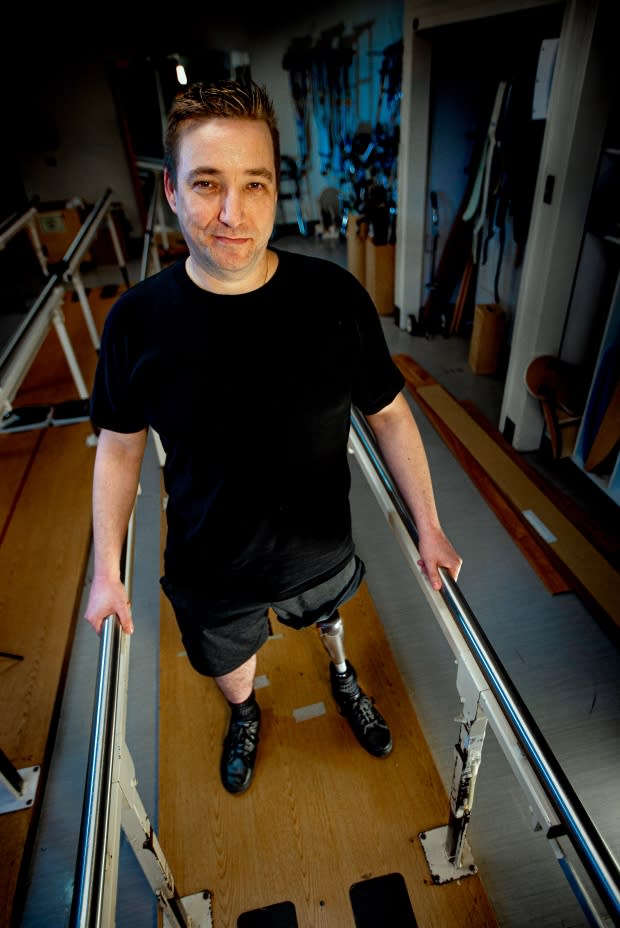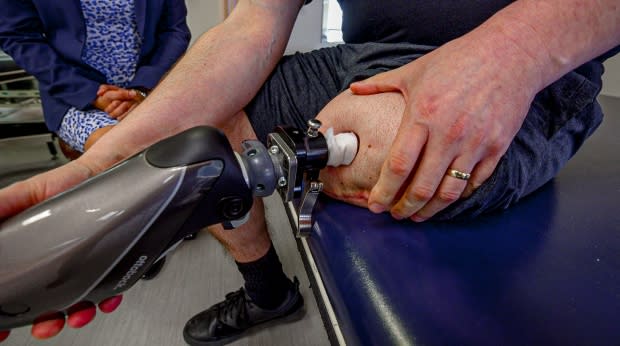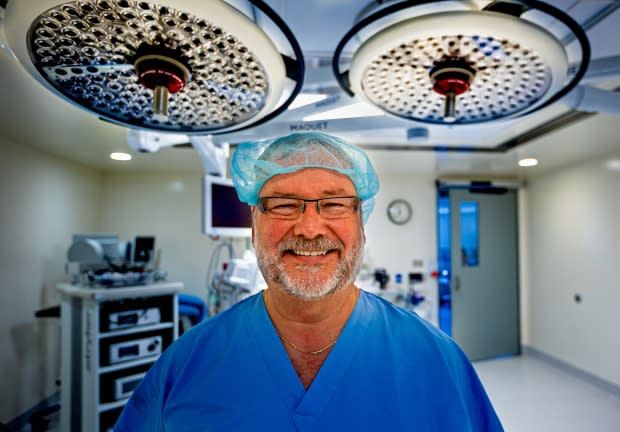Walking without pain: How a new surgical procedure is giving hope to some amputees
After losing part of his leg as a teenager, Jason Simunic has spent more than 30 years walking with pain, due to ill-fitting prosthetic limbs that irritate his skin and cause blisters. Now he hopes those days are behind him.
Simunic recently became the third patient in Canada to undergo osseointegration, a relatively new procedure aimed at giving amputees higher functionality, mobility and comfort.
With roots in dental surgery, osseointegration involves a surgeon inserting a titanium rod-like implant directly into the bone of an amputated limb, before connecting it to a prosthesis. The result is that the new artificial limb stays more firmly in place and doesn't move around, as it would in traditional socket-based prosthetic devices, which are often suctioned or strapped to a patient's body.
Because the implant is fused to the bone, patients, like Simunic, can sense surfaces — grass, sidewalks and floors — beneath the leg.
"I'm a bit nervous, I guess, anticipating the first steps of the rest of my life," Simunic said in an interview last March, a day before his osseointegration surgery, while resting at his home in Saint Lazare, Que.
Simunic lost his leg at age 14, during a family holiday in the Dominican Republic.
"Coming back from where we were staying, we struck a sugar cane truck. We collided with it, like a T-bone," the now-45-year-old recalled.
Simunic's leg and ankle were crushed. When he returned to Montreal, doctors had no choice but to amputate his leg, just above the knee.
"I had lived a very active lifestyle. I used to bike everywhere and [the] skateboard was my primary means of transportation, my hobby. So I was devastated to learn that … I wouldn't be able to do these things again."

Simunic recovered, got married and had three daughters. But he never got used to living with a conventional prosthesis.
He's had more than a dozen throughout the years — and none ever gave him any degree of comfort. They were hot, he said, and there was constant friction as the residual limb moved within the prosthetic socket.
"Quite frankly, I can't walk for more than 500 or 600 metres without it causing some irritation and pain."
His wife, Sarah, also saw the emotional toll it was taking on him. "We live in a beautiful neighbourhood and he hasn't been able to experience it the way the girls and I have been able to," she said.
About a decade ago, Simunic started hearing about osseointegration, and his research led him to Dr. Robert Turcotte, a Montreal orthopedic surgeon who was also looking into this procedure.
To learn more, Turcotte travelled to Australia, where the procedure has been revolutionized, thanks in part to Iraqi-born Dr. Munjed Al Muderis. He's since gone on to perform five osseointegration surgeries, with 10 more planned.
"We were convinced of the benefit back then. But back in Montreal, it was impossible to sell the idea and the concept to the authorities and to the hospital," said Turcotte.

Osseointegration is expensive. It can cost around $50,000 and no province currently covers it.
But the procedure is slowly gaining traction. Quebec recently announced it was going to provide some public funding for osseointegration — the first place in Canada to do so. And researchers at the University of Alberta in Edmonton are about to launch the first Canadian study of osseointegration, examining its benefits.
Dozens of Canadians are also believed to have gone abroad for the procedure.
At the time, Simunic contemplated remortgaging his house to pay for the surgery privately. But late last year, he learned that because he lost his leg in a car accident, Quebec's public auto insurance plan would pick up the cost.
Simunic soon found himself on an operating table, with Turcotte performing the three-hour surgery. Turcotte and his team inserted the implant directly into Simunic's femur, a portion of which was left protruding out of his residual limb. It would eventually be attached to a prosthetic device.
"This will allow bone regrowth. The bone will fuse with the implant to keep it very strong, a part of your body," said Turcotte.
'It's liberating'
Simunic's rehab began almost immediately at the Montreal Gingras-Lindsay Rehabilitation Institute, the only place in Quebec currently caring for osseointegration patients. Weeks of strengthening the leg and learning to bear weight on the stump all led to the moment when a simple click, fastening the prosthesis to the implant, changed Simunic's life.
"It was a totally new sensation. It's liberating in a sense to not have the socket," he said. "I felt I have to relearn everything."
Overseeing his rehabilitation was Montreal physiatrist, Dr. Natalie Habra. While osseointegration was a solution for Simunic, she said it's not an option for every amputee.

"Patients who are diabetic or who are amputees because of poor blood circulation are not candidates for this technology," said Habra. "It's patients who had traumatic amputations or cancers, those are the ones who are candidates for this surgery."
And not everyone believes this is the best course of action. Health Quality Ontario, an agency that monitors the quality of the province's health-care system, has decided against publicly funding osseointegration, saying the implants can cause "serious complications, including leg, soft tissue and bone infections."
As for Simunic, there's more work to be done. But spurring him on is the goal of spending time with his family — active and pain-free.
"Life is short and you only have so many days on this earth. I'm just tired of sitting by and watching it pass by in front of me."


